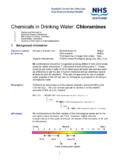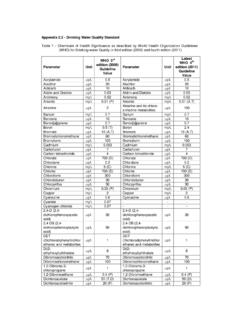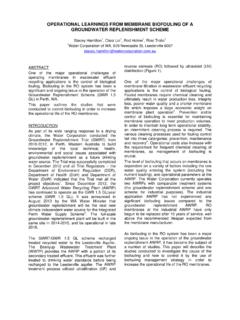Transcription of Environmental Guidelines and Regulations for …
1 1 Environmental Guidelines and Regulations for Nitrosamines: A Policy Summary Prepared for CO2 Technology Centre Mongstad by: Dr. Noelle E. Selin Assistant Professor of Engineering Systems and Atmospheric Chemistry Engineering Systems Division and Department of Earth, Atmospheric and Planetary Sciences Massachusetts Institute of Technology 77 Massachusetts Avenue (E40 379) Cambridge, MA 02139 4307 USA +1 617 324 2592 FINAL REPORT [REVISION 2] 2 Table of Contents Environmental Guidelines and Regulations for Nitrosamines: .. 1 A Policy Summary .. 1 Executive Summary .. 3 1. Introduction .. 4 Table 1. Nitrosamines covered by EPA Method 521.. 4 Figure 1. Structure of nitrosamines.. 5 Figure 2. Structure of N nitrosodimethylamine (NDMA).. 5 2. Health Risks of Nitrosamines .. 5 3. Nitrosamine Historical Analysis and Emerging Policies .. 5 Table 2. Timeline of Scientific Evidence and Policy Action on nitrosamines.
2 8 4. Calculation of Health related Risk Levels: Health related carcinogenicity Guidelines .. 9 Figure 3: Dose response relationships used in NDMA risk assessment .. 13 Table 3: NDMA Drinking water guideline values and associated risks .. 13 5. Environmental Levels: A Survey .. 14 6. Summary and Analysis .. 15 7. References .. 17 3 Executive Summary This report presents a summary of Environmental and human health Guidelines and Regulations for nitrosamines, focusing on the United States and selected international contexts. Many nitrosamines are carcinogenic; the most frequently investigated by regulatory authorities are N nitrosodimethylamine (NDMA) and N nitrosodiethylamine (NDEA). Both NDMA and NDEA have been classified by national and international regulatory authorities as probable human carcinogens. Numerous laboratory animal studies have linked exposure of these compounds to cancers. Some epidemiological evidence is available supporting a link to human cancers.
3 Historically, nitrosamines were of most regulatory interest due to their presence in food. However, recently NDMA has attracted renewed regulatory attention due to its presence as a drinking water contaminant. A number of studies measured NDMA near industrial sources. More recently, NDMA has been identified as a byproduct of drinking water disinfection. Regulatory development for NDMA concentrations in drinking water is ongoing under several authorities, including the United States, Canada and several European countries. Assessment of the carcinogenic risk posed by nitrosamines follows a general methodology of risk assessment, where animal studies are extrapolated and associated with human risk levels. Several assumptions are made in the carcinogen risk assessment process, including the choice of animal study and endpoint used, extrapolation methods, and characterizations of exposure pathways. These assumptions are applied differently by different regulatory authorities, resulting in a range of concentrations that are calculated to be associated with human risk.
4 Generally, a 10 5 or 10 6 risk level is applied to carcinogen risk assessments. Different risk assessments have calculated drinking water concentrations associated with these risks range between 100 ng/L. Environmental measurements exist for nitrosamines in drinking water as well as air and natural waters. The chemical pathways of nitrosamine formation and degradation in the atmosphere (particularly in the aqueous phase) remain uncertain. One area of uncertainty is the relative importance of industrial vs. background sources. 4 1. Introduction This report summarizes the Environmental and human health Guidelines and Regulations in the United States and selected international contexts on nitrosamines. It includes: a summary of the health related scientific information used in support of regulatory and risk analyses (Section 2); a historical analysis and timeline of Environmental and public health actions and emerging data about nitrosamines (Section 3); background information on calculation of action or reporting levels in regulatory context (Section 4); a comparative analysis of levels of nitrosamine Environmental concentrations at various sites and a survey of categories of sources of nitrosamines to the environment (Section 5).
5 A brief summary of emerging issues is presented in section 6, and references to peer reviewed literature and internet links to regulatory documentation are provided in Section 7. Nitrosamines are compounds of the chemical form R1 NNOR2 (see figure 1 for chemical structure). They are produced by the reaction of nitrite with secondary amines (Mirvish, 1995). While many nitrosamines are carcinogenic, some are not, and their potency varies depending on their molecular structure (Dai, 1998; Luan et al., 2005). N nitrosodimethylamine (NDMA), a highly potent carcinogen, is commonly detected and often used as an indicator compound for nitrosamines. The degree of carcinogenicity among these compounds varies dramatically. N Nitrosodiethylamine (NDEA) is the most potent carcinogen among the nitrosamines, and and N nitrosodiphenylamine (NDP(h)A) being 15,000 times less potent. (European Commission, 2007). The main compounds investigated by health and regulatory authorities have been NDMA (Figure 2) and NDEA.
6 The United States Environmental Protection Agency has also developed an analytical measurement method covering seven nitrosamines, which are listed in Table 1 (Munch and Bassett, 2004). Following policy activities in national and international settings, this report will focus on Regulations and supporting analyses produced for NDMA and NDEA, and will reference other nitrosamines, as appropriate and where information is available. It is important to note, however, that the use of a highly potent carcinogen as an indicator could lead to overestimating nitrosamine risks (European Commission, 2007). Table 1. Nitrosamines covered by EPA Method 521. Nitrosamine Analyte Chemical Abstract Services (CAS) Registry Number Detection Limit for EPA Method 521 (ng/L) N- nitrosodimethylamine (NDMA) 62-75-9 N-Nitrosomethylethylamine (NMEA) 10595-95-6 N-Nitrosodiethylamine (NDEA) 55-18-5 N-Nitrosodi-n-propylamine (NDPA) 621-64-7 N-Nitrosodi-n-butylamine (NDBA) 924-16-3 N-Nitrosopyrollidine (NPYR) 930-55-2 N-Nitrosopiperidine (NPIP) 100-75-4 5 Figure 1.
7 Structure of nitrosamines. From Luan et al., 2005. Figure 2. Structure of N nitrosodimethylamine (NDMA). From California Environmental Protection Agency, 2006. 2. Health Risks of Nitrosamines The health risk of most concern for Environmental levels of nitrosamine is carcinogenicity. Exposure to nitrosamine has been shown to form tumors in laboratory animals, and have been linked in epidemiological studies to human cancers including pancreatic cancer (Risch, 2003) and childhood brain tumors (Huncharek and Kupelnick, 2004). Nitrosamines are classified by a number of international organizations and regulatory authorities as to their carcinogenicity. Under the International Agency for Research on Cancer (IARC), which is part of the World Health Organization (WHO), NDMA and NDEA are classified as Group 2A substances (probably carcinogenic to humans). The European Union categorizes NDMA and NDEA as category 1B (Presumed to have carcinogenic potential for humans; largely based on animal evidence).
8 In the US, the Environmental Protection Agency classifies both NDMA and NDEA as a probable human carcinogen (category B2) under its 1986 carcinogen assessment Guidelines . 3. Nitrosamine Historical Analysis and Emerging Policies Nitrosamines initially gained regulatory concern due to their levels in food. For example, nitrates intentionally added to food as preservatives react with amines in cooking to form nitrosamines (Shapley, 1976). Food products that can contain nitrosamines include bacon and other cured meats, fish, cheese, and malt beverages including beer (ATSDR, 1989). Consumption of meats and foods with elevated levels 6 of nitrosamines have been linked in epidemiological studies to increased risk of cancer. Concentrations of nitrosamines in food have decreased over the last few decades due to regulation and decreases in added nitrates (Scanlan, 1995). Internationally, the World Health Organization in 2008 added NDMA to the third edition of its Guidelines for drinking water quality.
9 In addition to industrial processes, the WHO noted the recent identification of NDMA as a disinfection byproduct of water treatment processes as background to its substance profile. A background scientific assessment document was developed in 2006 for this guideline process. Industrial sources and emissions of NDMA produced a renewed interest in the compound in the 1990s. Nitrosamine formation has been associated with the production of rocket fuel. In 1998, NDMA was detected in a drinking water well near a facility in California, USA that used unsymmetrical dimethylhyrazine (UMDH) based rocket fuel (California DPH, 2010a; Mitch et al., 2003). Oxidation of UMDH produces NDMA. Surveys of drinking water in noncontaminated areas following this discovery also revealed the presence of nitrosamine in these water supplies. The production of NDMA in treated drinking water primarily results from chloramination processes. In Canada, a drinking water survey found nitrosamines in treated drinking water in 1989, and a similar survey in California detected nitrosamines in 2001.
10 Some drinking water samples showed concentrations greater than 10 ng L 1, though most fell below that level (Mitch et al., 2003). High concentrations have also been found in wastewater effluents. Few firm regulatory limits exist for the concentration of nitrosamines in the environment and in particular in drinking water (Mhlongo et al., 2009). However, regulatory guideline or assessment levels for Environmental media and in particular for drinking water have been set by a number of international, national and subnational authorities. In addition, growing concern about the presence of nitrosamines as disinfection byproducts ( substances produced as a result of processes used to reduce water bacteria levels) has prompted renewed interest in setting regulatory standards for these substances in North America and internationally. Nitrosamines are listed in a number of national Regulations in the United States. Under the Clean Water Act, which regulates surface water quality, nitrosamines are listed as a toxic pollutant.




